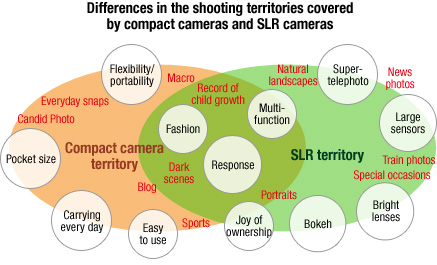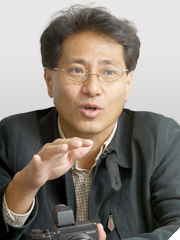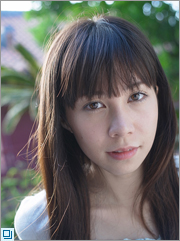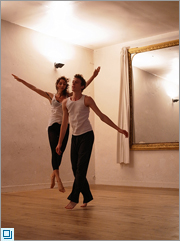Inside Story
What is the "drastic expansion of shooting territory" that the GXR has achieved?
In order to understand the world that exists beyond the limitations of the compact digital camera, it will be helpful to first take a quick look at the diagram showing the different shooting territories covered by compact digital cameras and digital SLR cameras.


"We wanted to make the best use of the
compact digital camera's flexibility and
portability and at the same time push
for higher image quality." (Ryo Fukui)
"Compact digital cameras use a small image sensor and can take photos that are in focus across a wide depth range. To shoot images that have shallow depth of field* and bokeh, however, a large image sensor is necessary so the consensus has been that you cannot take such pictures with a compact digital camera," explained Ryo Fukui, Products Planning Group member in the Personal Multimedia Products Company Planning Office. "The good point about a compact digital camera is that, because of its small size, when you discover a moment to be photographed, you can swiftly pull it out and get the shot. We wanted to create a camera that preserved this flexibility and portability while also being capable of taking photographs that until now were thought to require an SLR," he added.
- *Depth of field: The depth range that is in focus. For example, if a subject in the foreground and another subject in the background are both in focus, the image is said to have a deep depth of field.
Taking things to an extreme, if you want to shoot using the optimum lens and image sensor combination for all situations, you could, in theory, carry a large number of compact digital and SLR cameras with you. "However, this would result in a big, heavy load and by the time you get the camera out of the bag, the shutter chance will be gone," said Fukui, adding, "In order to achieve both portability and high image quality while drastically expanding compact digital camera shooting territory, we felt that we had to create a camera that satisfied the following three criteria."
- 1)A camera that can use the lens and image sensor combination optimum for the scene to be photographed.
- 2)A camera that (in order to achieve No. 1 above) can use the same large size image sensor as an SLR.
- 3)And at the same time, a camera that is as portable as a compact digital camera so the photographer does not have to carry around a heavy load of equipment.
Slogan: "Shooting the best of all worlds"
With systems in which only the lens is changed, the fixed image sensor must be able to accommodate a variety of lenses. In order to do this, ample space must be provided between the lens and the image sensor, unavoidably increasing body size. In addition, for the filter placed over the image sensor surface to prevent phenomena such as moiré, since only a single fixed filter can be used, it is not possible to optimize the filter for each lens. "When it is the camera unit that is changed, it is possible to match lens, image sensor, filter, and image processing engine tuning in order to achieve total optimization in a compact space," explained Fukui.
Sample images: Click to enlarge.With the GXR, even if a camera unit is changed, the body is still the same, so the photographer can enjoy using multiple lens and image sensor combinations with the same familiar operation methods. Furthermore, the GXR slide mount does not expose the image sensor or the back of the lens so there is no need to worry about dust when changing units, and the same body will be able to accommodate the various types of units to be born in the future. "The concept we held up as an ideal from the beginning of development was 'Shoot the best of all worlds.' To enable GXR users to thoroughly enjoy all aspects of the world of photography, from here on we will be working to create a variety of new units, some of which are not camera units," Fukui said.
- *Lens focal lengths in the text are all converted to 35 mm film camera equivalents.




